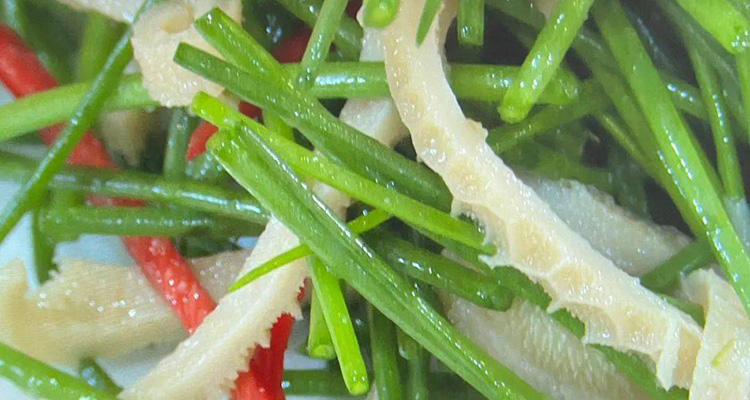Sand Scallion Lamb Tripe: Northwest Flavor
In China’s vast and mysterious northwest, sweeping deserts and open grasslands offer more than breathtaking scenery—they offer a unique culinary adventure. One dish you shouldn’t miss is Sand Scallion Lamb Tripe. Combining the fresh, herbal aroma of wild sand scallions with the chewy, crisp texture of lamb tripe, this specialty embodies the rugged generosity of the region. Born out of necessity and refined over generations, it offers an authentic taste of northwest China.
1. Origin and History: Survival Wisdom Born in the Sands
Sand Scallion Lamb Tripe emerged from the harsh conditions of northwest China. In arid steppes and gravelly deserts, hardy wild sand scallions provide essential greens, while sheep supply meat, milk, and hides for nomads. Using lamb tripe with sand scallions likely started as a practical way to balance flavors and avoid waste. Over time, this combination evolved into a regional favorite, telling a story of adaptation, resilience, and resourcefulness.
2. Cultural Significance: Hospitality of the Grasslands
Lamb is central to northwest hospitality—serving a whole sheep often marks the highest honor. Sand Scallion Lamb Tripe, while more of a home-style dish than a banquet centerpiece, reflects warmth and respect. Preparing tripe properly requires care: repeated washing and slow simmering. Eating it symbolizes genuine welcome, while the fresh aroma of sand scallions highlights the local instinct to balance richness with bright, natural flavors.

3. Ingredients Spotlight: Nature’s Gifts
- Sand Scallions: Unlike ordinary scallions, sand scallions are a hardy perennial plant in the lily family. Their hollow, tender leaves have a mild, slightly peppery fragrance that cuts through oiliness and neutralizes gamy notes. The best stalks are harvested in spring and early summer, eaten fresh or dried for winter.
- Lamb Tripe: The sheep’s stomach, ridged in texture, is carefully cleaned and blanched before being sliced into thin strips that stay crisp and springy when cooked. Well-prepared tripe has a subtle milky aroma; poorly prepared tripe can taste off, which is why sand scallions are an ideal partner.
4. Flavor and Texture: A Contrast That Works
The dish shines through contrast. Stir-fried tripe is springy and chewy, while sand scallions are tender, juicy, and slightly crisp. The fresh, mildly spicy aroma of scallions greets the nose first, followed by the rich, meaty scent of lamb tripe. Scallions neutralize any gaminess, leaving a bright, savory finish. Seasoned simply with salt, light soy, and sometimes a touch of cooking wine, the dish balances rustic boldness with subtle refinement.

5. Cooking Secrets: Patience and Technique
The key is preparation before the wok. Fresh tripe is massaged with flour and salt, rinsed thoroughly, and briefly simmered with ginger, scallion, and rice wine until tender, then shocked in ice water to firm up. Chilled tripe is sliced evenly. Fresh sand scallions need a quick wash and cut; dried scallions should be soaked. In the wok, heat oil until very hot, briefly toast chili and Sichuan pepper if desired, stir-fry the tripe, add sand scallions for a few seconds, season quickly, and serve immediately to preserve color, fragrance, and crunch.
6. How to Eat It: Pairings and Serving Ideas
Ideal for sharing, this dish pairs beautifully with local barley wine or beer. It can be served hot as a stir-fry or cold on a plate. For an authentic northwest experience, wrap the tripe and scallions in warm, flaky northwest-style flatbread—its wheaty aroma complements the savory flavors for a satisfying handheld bite.

7. Tips for Travelers: Where to Try the Most Authentic Versions
- Best regions: Gansu, Inner Mongolia, Ningxia, and Xinjiang offer authentic local versions—look for family-run restaurants, farmhouse inns, and pastoral homestays.
- Season: Spring and early summer provide the freshest wild sand scallions.
- Openness: If you’re new to offal, lamb tripe is approachable—the texture and balanced aromatics win over most first-timers.
8. Simple Home Version: Recreate the Flavor on the Road
- Purchase pre-cleaned, partially cooked tripe and dried sand scallions.
- Blanch the tripe in boiling water, then drain; soak dried scallions in warm water.
- Stir-fry garlic and chili in hot oil, add tripe briefly, then toss in the scallions.
- Season with a splash of cooking wine, light soy, salt, and a pinch of sugar. Stir-fry for 30 seconds and serve hot.
While a home version won’t fully replicate wild freshness, it captures the core textures and flavors.
9. Conclusion
Sand Scallion Lamb Tripe is more than a dish—it’s a culinary memory of the northwest steppes. Its simple ingredients reflect a people closely connected to the land: resilient, hospitable, and inventive. When you explore the Silk Road routes or camp on the grasslands, seek out this dish—it’s a delicious, authentic way to taste the character of northwest China.


